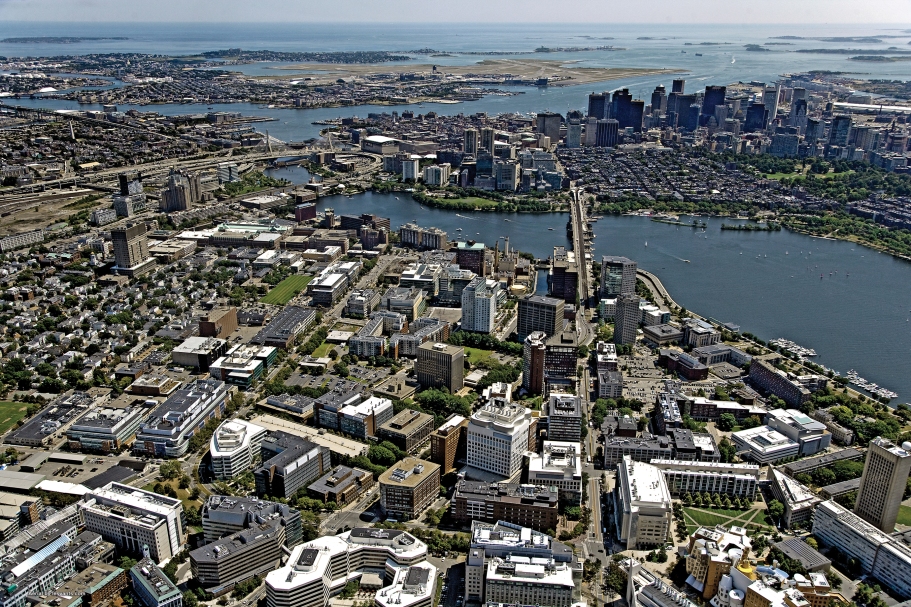SEE STORY ORIGINALLY PUBLISHED AT MIT TECHNOLOGY REVIEW
By Michael Blanding
August 18, 2015
The waitress brings over a cocktail snifter with two colored ice cubes, a thin wafer of sugar covering the rim. The goal is to crack the sugar, she explains, and quickly inhale the cachaça vapor inside. “It’s a primer for the palate, like an amuse bouche. It allows you to appreciate some of the subtleties of the alcohol,” she says, before pouring dark rum over the ice to complete the drink.
The Whaf Tiki, as it’s called, is the signature concoction of Café ArtScience, a restaurant in Cambridge’s Kendall Square. By five o’clock, workers from surrounding offices—Microsoft, Biogen, Google, Akamai, Facebook—are gathered at the bar for cocktails, deviled quail eggs, and hamachi crudo. Some venture across the lobby to Le Laboratoire, a gallery space where metal objects called Ophones emit subtle scents with names like Crackling Fire and Myrrhmetal in time with a soundtrack.
The space is the brainchild of David Edwards, a chemical engineer, Harvard professor, and inventor who came to Cambridge 30 years ago as a visiting graduate student at MIT. After selling his company, Advanced Inhalation Research, he launched Le Laboratoire, first in Paris, where he says “we were always seen as a bit of an extraterrestrial force.” Not so in Cambridge. “Here there is a sense of being a reflection of Kendall Square,” says Edwards. “I can’t imagine a community more aligned with our mission.”
Café ArtScience and Le Laboratoire are only the latest reflections of how far Kendall Square has come over the past several decades. In the last century, the smells wafting over the neighborhood came from a gas works, a vulcanized-rubber plant, and a rendering plant that disposed of carcasses from Boston’s stockyards. After the factories closed, the area became an abandoned wasteland. But slowly pioneers, many connected to MIT, reclaimed the space, building biotech and IT companies. By 2009, the Boston Consulting Group proclaimed Kendall Square—an area roughly defined as everything within a 10-minute walk of the Kendall T station—“the most innovative square mile on earth.”
Now MIT is poised to complete the transformation with a massive project to build six buildings with space for research and development facilities, offices, residences, restaurants, and shops. “We want to create a vibrant, exciting sense of place,” says MIT provost Martin Schmidt, SM ’83, PhD ’88. That, in turn, will spur new innovation, says executive vice president and treasurer Israel Ruiz, SM ’01: “Innovation is about human collision, and the power of proximity of the labs and those who can apply the science. We’re curating our front yard, if you will, to make that happen.”
After years of planning—and then revamping plans to incorporate feedback from faculty, city officials, and Cambridge residents—MIT won approval from the city to rezone Kendall Square in 2013. In July, the Institute filed its fleshed-out plan, which must clear one last hurdle. If it passes muster with the Cambridge Planning Board, which is expected to vote on it this fall or winter, the Institute will finally be able to see its vision through.
In 1969, the NASA building, One Broadway (then under construction), and Eastgate dominated the Kendall Square landscape, much of which had been cleared for NASA.
Act One: Kendall, we have a problem
For decades Houston, Texas, has been nearly synonymous with NASA. But had history gone differently, Kendall Square might have been just as strongly associated with the space agency, which in the mid-1960s announced plans to site its Electronics Research Center, with a proposed staff of 3,000, on land abutting MIT.
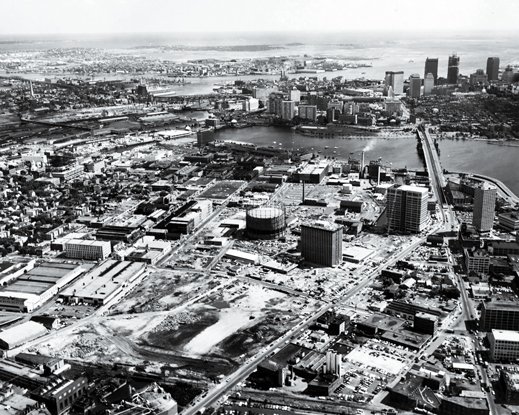
In 1969, the NASA building, One Broadway (then under construction), and Eastgate dominated the Kendall Square landscape, much of which had been cleared for NASA.
It was a logical choice. Since the Civil War, East Cambridge had been an industrial center, making goods ranging from telescope lenses to soap. By the mid-1940s, however, the factories began closing as companies sought cheaper labor elsewhere. After soap maker Lever Brothers—Cambridge’s biggest employer—pulled up stakes in 1959, the mayor turned to MIT president James Killian for help. In 1960, Killian announced that the Institute would purchase the former Lever Brothers site and begin developing it into office buildings to facilitate collaboration with industry. It was dubbed Technology Square.
After the first building opened, in 1963, companies including IBM, Grumman Aircraft, and Polaroid started moving in. Supported by President John F. Kennedy and Senator Ted Kennedy, NASA started eyeing the area as a home for its proposed scientific campus, where it hoped to develop new electronics systems for manned spaceflight and other programs. The city launched a massive redevelopment project to clear land and improve roads on 29 acres to accommodate the agency.
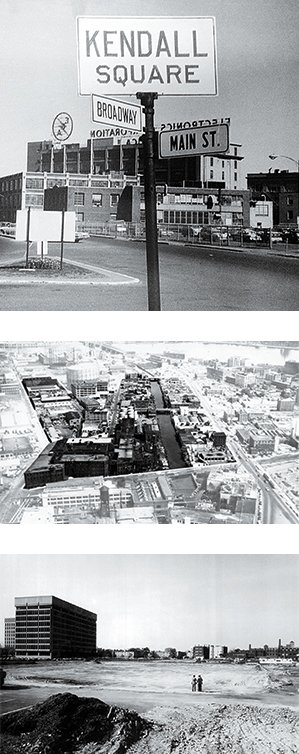
Point Park at Broadway and Main was long a small traffic island. Microsoft’s New England R&D (NERD) Center is now at One Memorial Drive, the site of the Electronics Corporation of America (behind the signs).
In this 1964 image with Broadway at right, the area (starting along the railroad tracks) proposed for the NASA site is darkened. Much of the Broad Canal was later filled in.
By the late 1960s, 400 Technology Square (and 500 Tech Square behind it) had been built. The empty lot in this undated photo would become Draper Laboratory.
Just a few years into the development, however, in 1969, President Richard Nixon abruptly ordered the new facility closed in a round of budget cuts, after only six of 14 planned buildings had been constructed. As a consolation prize, the federal secretary of transportation, John Volpe, maneuvered to move the National Transportation Center into the vacated buildings. But the development took up only half the land that had been cleared; much of Kendall Square became a giant parking lot. Locals sometimes called it “Nowhere Square.”
At the same time that the NASA project was screeching to a halt in Kendall, electronics companies were flocking to scoop up cheap land alongside Route 128, near MIT’s Lincoln Laboratory—adding to a suburban high-tech corridor that had started growing in the 1950s. The Cambridge Redevelopment Authority (CRA), which oversaw development of the NASA site, shifted course to woo some of them.
“If you were going to compete with the suburbs, you had to be more like the suburbs,” says Tom Evans, the CRA’s current executive director. The authority proceeded with its NASA-era project to widen the roads in Kendall, planning high-density, mixed-use “superblocks” for office parks arranged around central parking garages: workers could drive in, park, and never have to leave the building. “In the 1970s, it was very cutting-edge,” he says. In the center of the square, the agency enticed Boston Properties to build a series of brick buildings, which survive today as Kendall Center and the Marriott hotel. The effect was to wall MIT off from the residential neighborhood of East Cambridge. In fairness, Evans points out, Boston Properties was willing come to the area when few others were. But the tone for the neighborhood was set, taking decades to undo.
Act Two: Biotech to Big Pharma
As electronics companies pursued their R&D in the isolation of suburbia, there was another spark kindling in Cambridge—a revolution in life sciences.
In 1974, Professor Salvador Luria founded the MIT Center for Cancer Research, assembling a dream team of molecular biologists that would include five Nobel Prize winners. When one of them, Professor Phillip Sharp, HM ’96, decided to spin off his recombinant DNA technology into a business, he wanted the business to be as close to his lab as possible.
“All of this research had gone on in the university,” says Sharp (see “The Man Who Helped Launch Biotech”). “The employees we wanted to hire were out of the university.” Sharp and Harvard biochemist Wally Gilbert founded Biogen in Geneva in 1978, but they moved the fledgling company to a small factory building on Binney Street within five years. “The Volpe building was there, but the rest of it was open space,” he says. Genzyme and other companies followed suit, creating a hub for biotechnology that slowly expanded through the 1990s.
By that time, the dawn of the Internet had shifted computer engineering from hardware-intensive companies that needed large spaces to small startups that could get by with just a few computers and coders. Entrepreneurs began setting up shop in Kendall, a stone’s throw from MIT (by then home to World Wide Web inventor Tim Berners-Lee).

Genzyme’s future headquarters on Binney Street.
Many of these new companies got their start in the Cambridge Innovation Center, a space begun in 1999 by entrepreneur Tim Rowe, MBA ’95 (see “The Mayor of Kendall Square”), in property rented from MIT at One Broadway. Pooling the resources of many small companies, CIC was able to subdivide the large office building to create affordable space—and provide opportunities for tech entrepreneurs to collaborate and inspire each other.
Venture capital firms came calling, eventually moving in. “Today in Kendall Square we have $14 billion in venture capital under investment, and half of that capital is actually in a CIC building,” says Rowe. Next, larger tech firms such as Google and Amazon set up recruitment centers, ultimately opening their own new Kendall R&D divisions.
Bringing the evolution full circle, a new wave of life sciences companies have begun to join them. Like electronics manufacturers, big pharmaceutical companies had for decades prospered in huge suburban office parks. Many of their drugs are coming off patent over the next few years, without replacements in the pipeline. “So what to do when the goose stops laying the golden eggs?” says Rowe. “You have to go where the new goose is.”
The first Big Pharma company to move to Kendall Square was Swiss drugmaker Novartis, which repurposed the old NECCO building in 2003 and is completing the expansion of its headquarters this year on MIT-owned land on Mass. Ave. With more than 2,000 employees, it’s now Cambridge’s largest employer. Pfizer built its own gleaming new research hub in two buildings on Main Street, while AstraZeneca, Amgen, and Baxter have all opened R&D centers in Kendall in recent years. And shortly after Biogen moved into more spacious facilities in suburban Weston, in 2010, the company’s CEO admitted that the move had been a mistake; last year, it moved into a brand-new building it’s leasing on Binney Street as its profits doubled to record highs.
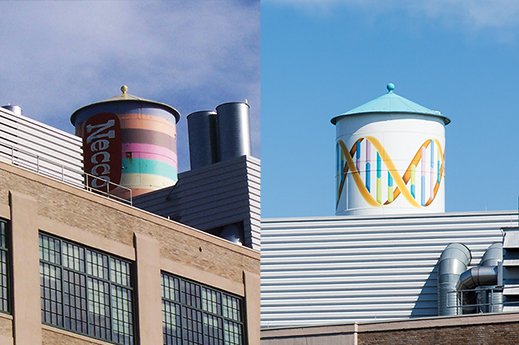
After Novartis moved into the NECCO building, it redecorated the water tower.
But even as home to an impressive collection of companies, Kendall still labored under the legacy of past decades—a largely uninviting stretch of big brick office buildings and wide streets deserted after quitting time. To change that, another kind of transformation was necessary.
Act Three: Putting the There There
It started with a haircut. Susan Hockfield, MIT’s president from 2004 to 2012, had just relocated to Cambridge from downtown New Haven, where she and her husband were Yale professors and she was provost. As the story goes, one weekend he walked from Gray House to Kendall Square to get a haircut and found the neighborhood almost deserted. Hockfield took note. Eager to turn the area into an active innovation district—with the services to match—in 2008 she asked the MIT Investment Management Corporation (MITIMCo), which oversees MIT’s real estate developments, to come up with a plan to help develop Kendall Square.
“She said, ‘There’s no place for my husband to get a haircut. There are no amenities. You have to build something,’” says Sarah Gallop, co-director of MIT’s Office of Government and Community Relations. MITIMCo went to the drawing board to figure out how it could revitalize the parcels it owned on Main Street.
“William Barton Rogers started with the notion that academics would collaborate with industry,” says MITIMCo’s managing director of real estate, Steve Marsh. “Part of our job is to build the ecosystem, the space around the Institute, which allows that to happen.” MITIMCo drew up a plan to serve both functions—placing buildings that could be rented out to biotech and IT companies and also support restaurants and retail.
MITIMCo submitted MIT’s plan to Cambridge in April 2011 and was met with a warm reception from the city, which had been working on its own plans to revitalize the area. For years, says city manager Rich Rossi, restaurateurs steered clear of Kendall after the demise of Polcari’s, an Italian restaurant at Tech Square. “We used to go to Polcari’s at lunchtime, and you would wait in line to get in,” says Rossi. “On Friday nights, you could choose any one of 250 seats.”
The city hoped to change the prevailing wisdom that Kendall was death to retail with the one card in its hand—zoning. Since developers needed approval from both the city council and the planning board, officials hoped they could enliven the area by requiring them to add more restaurants and housing.
Much of the credit for helping bring restaurants and other retail to Kendall belongs to Jesse Baerkahn, head of the retail development firm Graffito SP. When the developer Twining was looking for a restaurant for its Watermark Kendall apartments on Third Street, Baerkahn recruited Peter and Colleen McCarthy, who had won many awards in Inman Square with their eclectic American restaurant EVOO and were looking for a new location
Much of the credit for helping bring restaurants and other retail to Kendall belongs to Jesse Baerkahn, head of the retail development firm Graffito SP. When the developer Twining was looking for a restaurant for its Watermark Kendall apartments on Third Street, Baerkahn recruited Peter and Colleen McCarthy, who had won many awards in Inman Square with their eclectic American restaurant EVOO and were looking for a new location
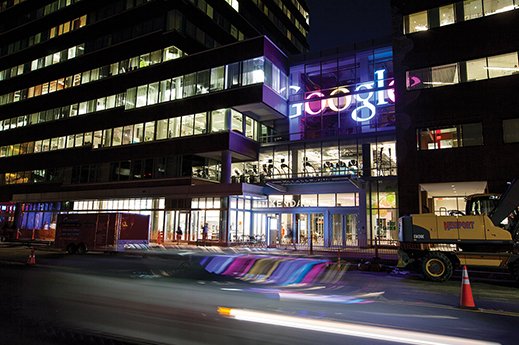
Clover Food Lab’s Kendall store and Google are in the same Main Street building.
The new EVOO was an instant success when it opened in 2010—popular not only with technology workers during the day but also with foodies who made a special trip in at night. The following year, Baerkahn brought in one of Greater Boston’s top French chefs—Michael Leviton of Lumière—to create Area Four. The infusion of new restaurants has made Kendall Square, however unlikely it once seemed, Boston’s food destination of the moment. Most of the restaurants, however, have taken root on the edges of the neighborhood. “There are still few places you can look across the street and see retail on both sides,” notes Baerkahn. MIT’s new development promised to change that, putting retail in the heart of the neighborhood. As city councilors considered MIT’s 2011 plan, they found a lot to like—along with one big problem.
Act Four: Filling In the Middle
Kendall Square has always lacked the housing needed to make it into a real neighborhood. During its heyday as a factory center, workers spilled out on both sides into triple-deckers in East Cambridge and Area Four (the neighborhood immediately to the west of Galileo Galilei Way); both neighborhoods remain some of the poorest parts of Cambridge.
Now the city council hoped to put people into homes in Kendall itself, infusing the neighborhood with new life after hours. The original plan that MIT presented to the city had only 60,000 square feet of housing—about 60 units—out of 1.2 million total square feet. That wasn’t good enough for city councilor Leland Cheung, MBA ’12. “I know postdocs who live out in Waltham because they can’t afford to live locally,” says Cheung, who urged MIT to increase the number of square feet designated for housing to at least 200,000.
City officials weren’t the only ones who wanted to see more housing—neighborhood groups also pushed for it, hoping to relieve upward pressure on prices. While affordable housing units can protect low-income renters, market-rate housing in the area had become increasingly unaffordable, squeezing out those in the middle, including professors, recent grads, and middle-class families with kids. “The most vulnerable people are able to stay here, and the rich are fine, but everybody in the middle is screwed,” says Cambridge resident Julian Cassa, a leader of the Area Four Coalition, a neighborhood group.

Kendall Square is loosely defined as a 10-minute walk from the Kendall T station.
Several of MIT’s own faculty also decried the 2011 plan, upset by its emphasis on commercial development over housing, says Jonathan King, a professor of biology, who argues that while commuting works for many academics, it’s essential for scientists to live close to the lab. “You can’t carry an electron microscope around,” he says.
In response to feedback from the city (which had commissioned its own urban planning analysis of Kendall Square in 2011), the neighborhoods, and the faculty, the Institute appointed a task force to study the development of MIT property in Kendall Square. Presenting its initial findings in October 2012, MIT’s task force flagged the need for additional housing—especially for graduate students—and recommended a housing study. (The Graduate Student Housing Working Group would eventually recommend that MIT build 500 to 600 new grad-student units now and an additional 400 over the next decade.)
In December 2012, MIT came forward with a revised plan, developed in a collaboration involving MITIMCo, senior administrators, planning staff, and the leadership of both the School of Architecture and Planning and the Department of Architecture. “We learned some lessons from this,” says MITIMCo’s Marsh. With input from that wider group, the new plan increased the space for housing to 240,000 square feet. It proposed demolishing the 201 units at the aging Eastgate graduate housing complex and building some 470 apartments in the center of Kendall Square over the T station, for a net of approximately 270 new grad-student apartments (since modified to 250). In addition, it would create 50 affordable housing units and 240 market-rate apartments wrapping around One Broadway.
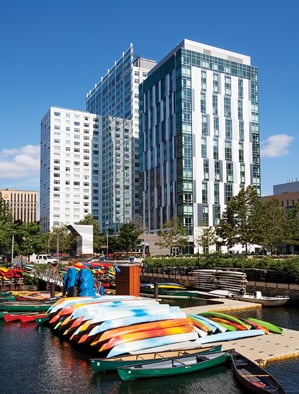
Kayaks rent for $15 an hour at Broad Canal Way; rent for a one-bedroom apartment at the Watermark Kendall East starts at $3,255 a month.
In the spring of 2013, two contingents of MIT speakers—including President Reif, former chancellor Phillip Clay, Institute Professors Robert Langer and Phillip Sharp, Broad Institute founding director Eric Lander, and Koch Institute director Tyler Jacks—appeared before the city council to advocate for MIT’s rezoning petition. The council was satisfied, voting 5–3 to approve zoning for the plan in April. Some faculty still express concern that the proposed graduate housing units represent only half the short-term amount recommended by the working group. According to Gallop, the Institute plans to add more graduate housing as part of later developments elsewhere on campus, though specific plans are still in the works
More fundamentally, some question MIT’s wisdom in building commercial real estate rather than using the parcels for controlled expansion of the academic facilities. “This is essentially MIT’s dowry, and once you give this away, you give this away,” says former MIT planning director Bob Simha, MCP ’57. “These are savings accounts for the institution.” The current plan adds some 230,000 square feet of academic space and preserves an additional 570,000 square feet for future academic developments. But some critics worry that if more space is needed, departments might have to rent it from MITIMCo or other developers, which would increase overhead and reduce their competitiveness in applying for grants. “That truly weakens MIT’s role as an international research university,” says King.
Gallop, however, puts that risk in perspective. She notes that space allocation is handled at the Institute level, and MIT could decide to build if additional space is needed. Even if departments did have to rent in the short term, she says that MIT has an agreement with the city allowing it to shift property from commercial to academic use over a four- to five-year period. Meanwhile, the Institute not only reaps financial return for the endowment but also benefits from the increased vibrancy of the campus. As part of the initiative, the MIT Museum will move to a new building next to the T station, opening out onto a park with Ping-Pong tables, fire pits in winter, public art, and other amenities.
Perhaps more important, in a deal worked out with the city, all the commercial real estate ventures will set aside 5 percent of their square footage for “innovation space”—small, affordable offices for startup companies. Already, MIT has made a down payment on that obligation by helping establish LabCentral, cofounded by CIC’s Tim Rowe, which promises to do for life-science companies what the Cambridge Innovation Center has done for tech startups. It provides lab facilities and offices for more than 100 scientists and 28 companies at 700 Main Street.
Meanwhile, Kendall Square continues to attract large companies. Most recently, the Dutch lighting and medical-device company Philips announced plans to move its North American research headquarters to the outskirts of Kendall—making it one of the first major companies outside the fields of IT and life sciences to do so. At the same time, it will form an “alliance” with MIT, paying $25 million over five years to partner on research.
“Faculty spend decades building expertise,” says associate provost Karen Gleason ’82, SM ’82, who inked the deal. “This gives them access to that expertise on day one.”
Act Five: [Insert Future Here]
As Kendall Square transforms, it risks becoming a victim of its own success. Over the past decade, commercial rents have jumped from $35 a square foot to the $70 to $90 range, forcing many technology companies that outgrow the incubator stage to retreat to downtown Boston, Charlestown, Waltham, or even Worcester.
That’s not necessarily a bad thing. “I see Kendall Square as being the heartbeat for innovation and technology in the state,” says Katie Stebbins, Massachusetts’s assistant secretary of innovation, technology, and entrepreneurship. “The incubator effect Kendall Square is having on the suburbs and cities around it is a positive for the region.”
That effect works only as long as Kendall can support small, innovative companies that can collaborate with Big Tech and Big Pharma. The set-asides for innovation space will help, but what happens when companies outgrow spaces like CIC and LabCentral? (See “Startup Central”).
“What’s critical to the innovation economy is to have businesses at all stages of the life cycle,” says Iram Farooq, Cambridge’s acting assistant city manager for community development, who notes there are few zoning tools the city can use to ensure that range.
But MIT is not the only developer in Kendall Square, and to some extent the biggest hope for addressing the affordability crisis lies in the market itself. Alexandria Real Estate—the current owner of Technology Square—is building a 2.6-million-square-foot mixed-use project on Binney Street that will include two residential towers and a new headquarters for Genzyme; Boston Properties is building an apartment high-rise on Ames Street; and the federal government announced it is open to selling the bulk of the Volpe Center, freeing up a dozen acres for new development.
That’s caused some to dream big. “I proposed we do a 1,000-foot tower,” says city councilor Cheung, who envisions it in part as a way to help address the housing crunch. “If Kendall Square is the economic hub of the region, and Cambridge is the intellectual hub of the nation, why shouldn’t the tallest building in New England be in the heart of Kendall Square?”
Whether or not that tower ever arises, the city, MIT, and the companies themselves all hope that the increased space from all these developments will continue to allow Kendall to expand, with new companies and residents building on its unique mix of innovation and culture for years to come.
“You could imagine years from now going and tracing something back to Kendall Square that really changed the world,” says MIT’s Ruiz. “If through our efforts we will have made it possible to solve something that we otherwise wouldn’t have been able to solve, that will be the best prize.”

